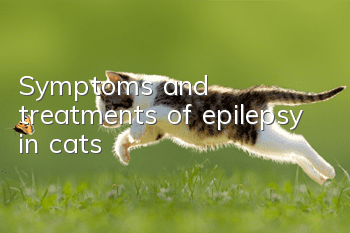Symptoms and treatments of epilepsy in cats

Cat epilepsy (Epilepsy) can be caused by genetics or acquired diseases. Owners cannot turn a blind eye when a cat has epilepsy, because a cat in the epileptic stage is likely to suffocate, and epilepsy often indicates other underlying diseases.
1. Causes of epilepsy in cats
This disease is divided into the following two types.
1. True epilepsy: a phenomenon that lacks clear brain tissue lesions and presents idiopathic epileptic seizures. The disease is closely related to genetic factors or unexplained functional (metabolic) factors. But this type of epilepsy in cats is extremely rare.
2. Symptomatic epilepsy: organic brain lesions caused by brain disease or injury, resulting in epileptic seizures. This type of epilepsy in cats can be seen in the following diseases.
Tumor diseases: myeloma (old cats) and lymphosarcoma (young cats).
Infectious diseases Toxoplasmosis, cryptococcosis, feline infectious peritonitis, encephalitis and encephalomyelitis.
Toxic diseases: lead, polyacetaldehyde, organophosphorus and streptomycin poisoning.
Metabolic diseases Vitamin B1 deficiency, hypoglycemia, hypocalcemia and uremia.
Other diseases Trauma, insufficient oxygen supply to the brain, and hydrocephalus.
2. The occurrence rate of two types: True epilepsy in cats is extremely rare, and most of them are symptomatic epilepsy.
What are the symptoms of epilepsy in cats
The symptoms of cat epilepsy can be divided into three stages: precursor, seizure and post-ictal symptoms. The frequency and duration of attacks in sick cats are closely related to the breed and size of the cat. So what are the symptoms when cats suffer from epilepsy?
1. Symptoms
1. Premonition:
A few minutes to a few days before the epileptic seizure, the sick cat showed depression, hyperactivity, and playful behavior that were different from usual. Observant cat owners can detect these abnormalities. But first-time cats or careless cat owners may miss these findings.
2. Epileptic seizure
1) Sudden loss of consciousness and convulsions based on the aforementioned precursors, or without any precursors at all.
2) The sick cat has a staggering gait, tonic or paroxysmal convulsions, and falls to the ground with a cry and is unconscious. Mydriasis, eyeballs rolled back, limbs spread, tonic or paroxysmal twitching, swimming-like movements. Head and neck muscle twitching, strabismus and nystagmus, foamy salivation caused by intermittent spasm of the masseter muscle can be seen, and sometimes bleeding caused by tongue bite can be seen.
3) Due to loss of consciousness, they often have urinary and fecal incontinence and do not know their owners at all.
3. Symptoms after epileptic seizure:
After waking up, the cat staggers, walks in circles, falls asleep due to fatigue after a short period of mania, or displays abnormal appetite. However, most sick cats recover immediately and do not see these post-attack symptoms.
4. Passage:
Most cases have a chronic course, manifested by irregular recurring attacks.
Diagnosis and treatment of epilepsy in cats
1. Diagnosis
1. Chief Complaint: The diagnosis of this disease can be easily made through the repeated and characteristic epileptic seizure symptoms of the sick cat described by the cat owner.
2. When encountering epileptic seizures, a general clinical examination and neurological examination should be carried out. After all factors considered are eliminated one by one, a judgment is made whether it is true epilepsy or symptomatic epilepsy.
2. Treatment
1. For cases where the attack lasts for less than 5 minutes, wait and see if there is any difficulty in breathing. Treatment may not necessarily be required. For longer lasting attacks, give phenobarbital 5 to 10 mg/kg subcutaneously.
2. If the attack lasts for more than 10 to 15 minutes and is severe, diazepam should be given 1 to 5 mg each time, with a total dose of 5 to 30 mg intravenously. When this medicine cannot suppress the attack, give phenobarbital 30~180mg and inject slowly intravenously until the attack is relieved. For cases of recurrent convulsions, administration is repeated every 4 to 6 hours.
3. After the cause of symptomatic epilepsy is identified, the cause can be treated. However, those with more severe attacks should also receive treatment to suppress the attacks.
4. Cats with acute epileptic seizures or those with other central nervous system symptoms usually need to be given vitamin B1 (5~10mg subcutaneous injection).
3. Methods to suppress epileptic seizures
1. Phenobarbital is taken orally at 4 to 10 mg/kg 2 to 3 times a day, which can be increased to 20 mg/kg as needed. This drug is the first choice drug for preventing and treating epileptic seizures.
2. Diazepam, 2~5mg daily, taken orally in 3~4 times.
3. Phenothiazine inducers, phenytoin, pilamidon and other sedatives can easily induce epileptic seizures or cause poisoning, and are contraindicated in sick cats.
- A cat will die if it urinates for a few days
- Should you deworm yourself or go to a pet store?
- Are cat teasers harmful to cats?
- What should I do if my cat suffers from chronic gingivitis?
- Cat's nails are cracked with a thin layer
- Cats go crazy after eating mutton
- What does cat moss on a cat’s chin look like?
- Can cats reproduce after abdominal transmission is cured?
- What exactly is the sterilization shot for female cats?
- Can I still eat unopened cat food if it has expired?



